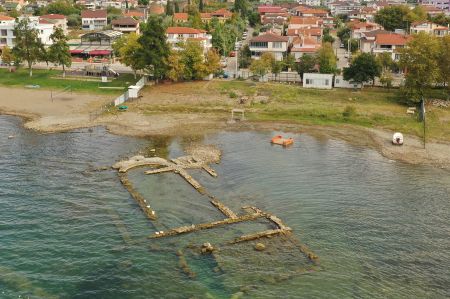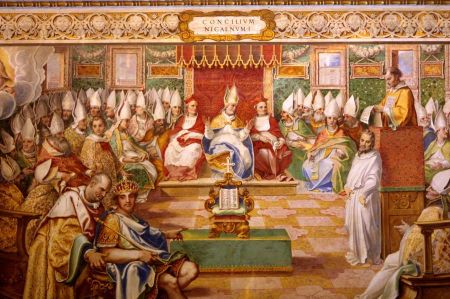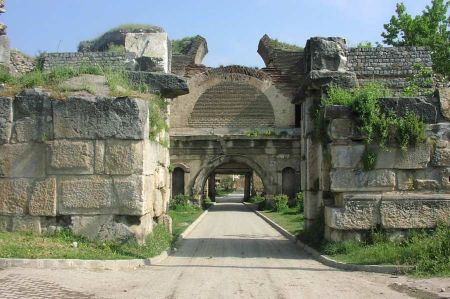İznik- the ancient Byzantine Nikaia
- Written by Portal Editor
On the way from Bursa towards Eskesehir we had made a short stopover on the D 200 near Inegöl for lunch in one of the many restaurants along the road.
Anyone who drives the route should know that Inegöl also stands for a nationally known dish, the so-called Inegöl Kofte, small rolls of minced meat, which are delicious and not too spicy, grilled over charcoal and served with fresh salad and bread. And as expected, we can only recommend these extraordinary heads, very tasty when freshly prepared, as in the restaurant we have chosen.
A little later we arrived at the intersection of the D200 and the D595 and spontaneously we drove in the direction of Iznik, which had been on our list of places to visit for a while due to its Roman past. Even today it can only be a short visit due to the advanced time, but it was only a good 45 kilometers to the former Roman imperial residence Nicomedia in Nikaia.

Nicaia rose to great importance in late antiquity, for some of the ecumenical councils that were to be considered essential in the history of Christianity were held here.
First Council of Nicaea

No minutes were taken at the council itself, even if some alleged minutes later surfaced. However, there are contemporary documents and reports about it, so that the essential events at the Council are historically undisputed today:
- The twenty canons, the Confession of Nicaea and the official decree of the Council have survived as official records.
- Reports have been preserved from three participants in the council who belonged to different schools, namely Eustathios of Antioch (anti-Arians), who may have been one of the presiding officers, Eusebius of Caesarea (Arians) and Athanasius (anti-Arians).
- There are also several letters about the Council of Alexander of Alexandria and Emperor Constantine I.
- There are reports from the late fourth and fifth centuries by the church historians Rufinus of Aquileia, Theodoret, Socrates Scholastikos and Sozomenos.
Nikaia was subsequently the capital of the subject of Opsikion, which was first mentioned in 680.
The Second Council of Nicaea
The Second Council of Nicaea allowed the veneration of icons in the so-called icon controversy, but not the veneration, although the veneration only under certain conditions. It essentially followed the arguments of John of Damascus. The iconoclastic Council of Hiereia of 754 was declared invalid and a "pseudo-synod".
However, her position as empress gave rise to other problems with far-reaching consequences: Under Roman law, no woman could have the supreme command of the army. As the Emperor held this position ex officio, legally she could only be Empress. Therefore, according to some sources, Pope Leo III. the Roman imperial throne as vacant and crowned Charlemagne as Roman Emperor in 800. This act officially eliminated the Eastern Roman Empire for the western world and restored the Western Roman Empire.
In 1077, Nicaea was conquered by the Rum Seljuks, who subsequently established their first capital here. However, after a siege by the crusaders of the First Crusade in 1097, the city reverted to the Byzantine Empire, which was able to persuade the Turkish garrison to surrender in order to avoid the city being plundered by the crusaders. The crusaders perceived this behaviour of the Byzantine emperor as a betrayal.
Under the Ottomans, Nicaea, which was then renamed İznik, developed alongside Kütahya into a preeminent centre of ceramics production (İznik ware). In Persia and Asia Minor, when the Seljuks took power, ceramic production began to flourish again, but due to the brisk building activity of the patrons, the focus was on the manufacture of tiles; Crockery and figurative ceramics only played a secondary role. Numerous new techniques for manufacturing and glazing the goods were also developed. This development could be continued under the Ottomans.
A little later we were able to see the ancient city wall with its gates, some of which were well preserved, some churches and the Roman theatre. It must have been a magnificent city that is worth exploring further. Probably the oldest building in the city is the church of Hagia Sophia from the 4th century. Here in the building the seventh ecumenical council was held.
Orhan I converted the church, also known as Hagia Sophia in Isnik, into a mosque. The mosque had been unused for a long period of time and was almost in ruins until it was turned into a museum after the founding of modern Turkey.
On the initiative of Turkey's Deputy Prime Minister - and member of the Islamic ruling party AKP - Bülent Arınç, the Hagia Sophia Museum has been used as a mosque again since November 2011, despite strong protests from the local city administration.
Homemade Inegöl Kofte - A recipe for 4 people
1 kilo streaky ground beef (streaky)
6 pinches of baking soda
1 level teaspoon of salt
1 medium onion
Preparation
The met should be mixed with the baking soda one day before preparing the Inegöl Köfte and then left to rest overnight.
The following day, the onions are chopped as finely as possible with a blender or knife and rinsed under running water using a sieve.
Now onions and salt are thoroughly mixed with the ground pork.
The kofta are formed into balls about the size of a walnut and rolled out with light pressure and then grilled on the charcoal grill.
Freshly baked bread and a mixed salad are also eaten, sometimes with a portion of rice.
Please read as well:
Pilgrims – Islamic Hajj, Christian routes and Jewish pilgrimage
